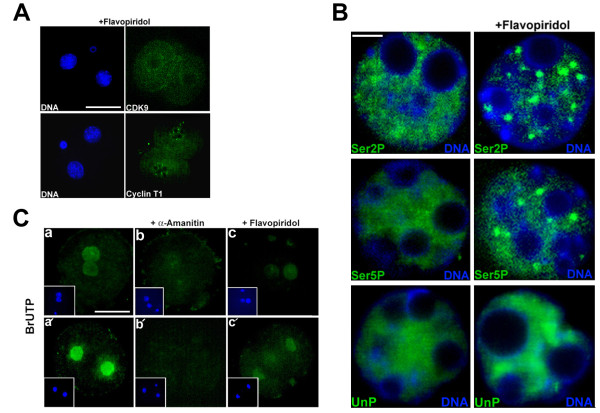Figure 3.
Effects of flavopiridol on localization of CDK9/cyclin T1 and phosphorylated Pol II CTD, and on transcription in embryos. A. Early one-cell stage mouse embryos were cultured in the presence of 100 nM flavopiridol to the two-cell stage and the embryos were next subjected to immunolabeling to detect cyclin T1 and CDK9 (separately). The experiment was repeated three times; 30 embryos were analyzed in total. Bar: 50 μm. B. Early one-cell stage mouse embryos were cultured in the absence (left) or presence (right) of 100 nM flavopiridol to the two-cell stage and immunostained with antibodies detecting phosphorylated serine 2 (Ser2P), phosphorylated serine 5 (Ser5P) or unphosphorylated (UnP) Pol II CTD. The Figure depicts CTD phosphoforms staining in one nucleus of two-cell embryos. The experiment was repeated three times. Bar: 5 μm. C. Early one-cell-stage embryos were cultured in KSOM for 9 h or 32 h in the absence (left) or presence of 250 μg/ml α-amanitin (middle) or 100 nM flavopiridol (right) and subjected to in situ run-on transcription assay. Embryos were permeabilized and incubated in transcription buffer containing 100 μM BrUTP. a, control late one-cell stage embryo. b, late one-cell stage embryo treated with α-amanitin. c, late one-cell stage embryo treated with flavopiridol. a', control two-cell stage embryo. b', two-cell stage embryo treated with α-amanitin. c', two-cell stage embryo treated with flavopiridol. The staining evident at the periphery is attributable to non-specific binding of the secondary antibody to the zona pellucida. Bar: 50 μm.

